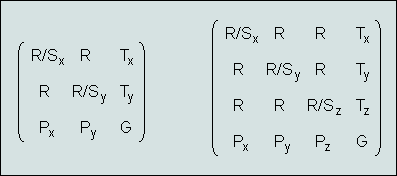| The Compendium Geometry is an eBook providing facts, formulas and explanations about geometry. |

|

Home  Coordinate Systems Coordinate Systems  Homogeneous Coordinates Homogeneous Coordinates  Definition Definition |
|||||||||||






|
|||||||||||
Homogeneous CoordinatesHomogeneous coordinates are a simple and efficient means to perform geometric transformations by matrix multiplication. The entire set of geometric transformations, can be combined into a 4×4 matrix (or into a 3×3 matrix in the case of two-dimensional coordinates):
Homogeneous coordinates exhibit several benefits:
In order to apply homogeneous transformations the (augmented) original data vector is multiplied by the transformation matrix. The resulting 3rd or 4th coordinate is either discarded or used to create a perspective view (see 3D projections).
|
|||||||||||
Home  Coordinate Systems Coordinate Systems  Homogeneous Coordinates Homogeneous Coordinates  Definition Definition |
|||||||||||
Last Update: 2010-12-06



 h, y
h, y